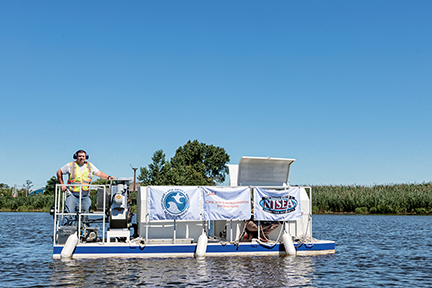From the Interim Provost
Atam P. Dhawan
Interim Provost and Senior Executive Vice President
Senior Vice Provost for Research
Distinguished Professor of Electrical and Computer Engineering
Building Resilience
Scientific Innovation for a Sustainable, Equitable Future
Learn MoreConstruction Engineering
Lab-Simulated Earthquakes - Test the Mettle of ‘High-Performance’ Building Materials
Learn MoreSustainable Design
Mapping an Ancient Solution to a Modern Crisis
Learn MoreEnvironmental Chemistry
The Rise of a Climate-Triggered Neurotoxin in the Arctic Tundra
Learn MoreNJIT in the World
Alumni Q&A
Learn MoreWater Remediation
Harvesting the Toxic Blooms of Summer
Learn MoreDiversity in Science
Shark Science
Learn MoreUndergraduate Research
From City Streets to Waterways, Undergraduates Use Data for Change
Learn MoreDefusing Disaster
Defusing Disaster
Learn MoreESSAY - Novel Building Materials
Converting Yesterday’s Rubble into Tomorrow’s Cities
Learn MorePower Electronics
Working the Wind
Learn MoreLanguage Development
Singing Lessons
Learn MoreApplied Optics
Tracking a Deadly Rise, Historic Fall of Insect Populations
Learn MoreEconomics of Recycling
New Futures for Old Plastics
Learn MoreCommunity-Engaged Architecture
Tiny Home Designs Offer Big Community
Learn MoreNew Faculty
New Faculty
Learn MoreFaculty Accomplishments
Faculty Accomplishments
Learn MoreResearch at NJIT: By the Numbers
Research at NJIT: By the Numbers
Learn MoreView and Download PDF
View or download the complete PDF.
Above: In his laboratory, Wen Zhang tests nano- and microbubble technology designed to bring tiny microalgae to the water’s surface, where it can be scooped up.
Amid summer’s cornucopia, there is one proliferation that is universally dreaded: the toxic algae blooms that float on lakes and streams, killing fish, gobbling oxygen from the water and chasing away swimmers. Composed of tiny organisms such as single-cell phytoplankton, microalgae and cyanobacteria, the phosphorescent blue-green clusters are impossible to miss, but difficult to capture.
“Compared to weeds and other aquatic plants, microalgae are tiny — between 1 and 10 micrometers in width — and so there is no easy way to remove them mechanically,” explains Wen Zhang, director of NJIT’s Sustainable Environmental Nanotechnology and Nanointerfaces Laboratory, who is working with a team of biologists, engineers and entrepreneurs on a new plan of attack.
Last summer, the team launched a custom-designed boat on New Jersey’s Deal Lake that scooped up algae-laden water for treatment on board. Central to the technology is a device that injects nano- and microbubbles of air into the lake, lifting algae from as deep as four feet to the surface for collection by skimmers.
Researchers have discovered that tiny bubbles have a host of useful properties. Suspended in liquids, they have a high degree of stability against dissolution and collapse. Their high surface area and their random movements allow them to move materials around, including nutrients, to enhance plant growth, ozone used in bacteria disinfection and oxygen needed to aerate hypoxic environments.
“Bubbles that are 100-500 micrometers in diameter rise quickly to the surface, and because they’re negatively charged and adhesive, lift the clinging algae,” Zhang says. “We’re also hoping to use this technology to raise dissolved oxygen levels. We’ve found that even finer bubbles, between 100-300 nanometers in diameter, stay suspended in the water much longer, where they slowly collapse and dissolve, boosting oxygen levels for up to five days. This is much better than standard aeration. They also remediate anaerobic processes that produce smelly odors and blackish water.”
Zhang’s team, which is funded by the New Jersey Department of Environmental Protection, is working with the Meadowlands Research and Restoration Institute (MRRI) and BRISEA Inc., an environmental and energy services company, to demonstrate their prototype’s effectiveness in clearing algae. They are also developing a long-term strategy to monitor other water quality parameters, such as dissolved oxygen and turbidity, on state lakes.
The team has modified the boat design several times to improve its efficiency and safety, for both operators and the equipment, says Likun Hua, a former Ph.D. student of Zhang’s who is now the director of technology validation and prototypes at BRISEA. “We decided on a pontoon boat, for example, which allowed us to locate the equipment inside the hull, lowering the boat’s height to fit under bridges.”
After driving the boat back and forth over sections of Deal Lake, researchers recorded increases in dissolved oxygen levels of more than 300%, and reduced turbidity where algae was removed.
They will also test related technologies, such as iron-based nanoparticles with magnetic properties Zhang developed several years ago to absorb the algae and then separate it with a magnet via a process called electrophoresis.
“We’re seeing more and more problems caused by fertilizer and rising water temperatures,” says Francisco Artigas, MRRI’s chief scientist and co-director. “A mechanical approach to removing blue-green algae from freshwater lakes using micro- and nanobubbles is possible. However, this is not a long-term solution to the problem. The solution is through community education and rules to prevent the blooms from happening in the first place by preventing the discharge of fertilizers and nutrients into natural freshwater bodies.”

Brian Wlodawski, senior geographic information systems specialist, goes for a test-run on the Hackensack River in a prototype of a custom-designed boat that uses nano- and microbubble technology to remove harmful algae blooms from New Jersey rivers and lakes.
